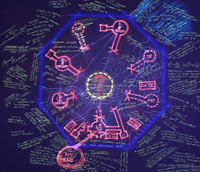A multi-purpose title, as will hopefully become clear.
Submitted for your approval is one Theresa Cano. Theresa was a character in the early drafts of The Suffering Map, my first solid attempt at a novel. She’s a young woman who works as a cleaning lady in San Diego to pay for her night courses in computer engineering. Theresa’s going to build the first thinking computer, you see. As it turns out, one of Theresa’s regular employers is an antique store owner named Lois Antanello. Lois is kind of an old bitch, to be honest (she is one of the lesser villians of the book), but she pays well so Theresa bites her tongue when Lois snidely refers to her “immigrant accent.” Theresa has no accent, you see, because her family’s been living (legally) in southern California for about fifty years longer than the Antanellos, who showed up just after World War II. As it happens in the story, Theresa is working there in the antique shop one day when Lois gets a disturbing phone call from her namesake, her Uncle Louis, who is, as some folks might say, a very bad man.
Keep all that in mind. We’ll be getting back to Theresa in a bit.
Names and descriptions are a kind of shorthand for readers. They let the readers know this person is important. They could be the protagonist’s best friend, an old lover, or an old rival. Maybe we’re supposed to note the color of their eyes or just remember them when their dead body shows up fifty pages from now. We don’t know yet why they’re important because the story’s just beginning. But when the writer takes the time to give us someone’s name and what they look like, that’s a sign to us we need to remember this person. They’re an actual character.
As such, a horrible mistake beginning writers tend to make is when they name and describe everyone. Every single person on the page gets a name, age, body type, ethnicity, and a quick (or not so quick) personal history. This is great for your main character, but it really sucks for the waitress who’s just saying “your drink, sir,” and putting a glass on the table.
The problem is that naming everyone clutters the story with characters. Yes, characters are great and they really make your writing. You can’t have good writing without good characters. However, pointless characters just drag on a story. As the reader, I’m trying to keep track of the important people and getting bombarded with the unimportant ones. An excess of characters is like that lady on the sinking ship who keeps insisting she needs to bring all fifty items of luggage into the lifeboat. All we really need to get moving is to get her in the lifeboat, but as long as she’s taking her time with hatboxes, makeup cases, and steamer trunks we’re not going anywhere.
Did you catch that? The sentence where I listed out all the types of luggage was kind of clumsy, wasn’t it? Because we don’t need to know all that. Your mind trips over it because, as an experienced reader, you instinctively know it’s not that relevant.
In his book Creating Short Fiction (check out the carousel at the bottom of the page) Damon Knight explains that a fact we don’t know is information, but a fact we already know is just noise. I’d add to that by saying a fact we don’t need to know is also noise, it just takes a bit longer to recognize it.
This mistake is lethal in scripts. Would you spend a full paragraph describing that waitress in so much detail in a novel? Then why would you do it in a screenplay, where the object is to make your writing as lean and tight as possible? Think about it. One hundred and fifty words spent on the hopes and dreams and legs of the cute waitress is 150 words you don’t get to spend on your main character. Or on that climactic action scene. So why waste those words on someone who doesn’t matter? There’s a reason people in film production refer to those folks as “background” or “extras,” and not as cast members. If we know she’s a cute waitress, that’s all we need to know.
Can you imagine reading the lobby scene in The Matrix if every person was named and described? The four cops at the metal detector when Neo and Trinity walk in. The two dozen guards who come filing out into the lobby. The whole scene would drag like nobody’s business. It’d be four pages of description before Neo even pulled out his second set of guns. Sure, maybe those guys have wives, kids, rich lives, and a lot of that, but for the purposes of this story they’re just there to catch a lot of bullets and a few kicks from Trinity. The screenwriters of The Matrix knew that none of those guys mattered, which is why that scene is barely half a page long.
And, yes, I used to do this myself. Remember Theresa? She existed for no other purpose but to overhear the start of a phone conversation. We never saw her before. We never saw her again. When I removed her from The Suffering Map it didn’t even cause a ripple. She was nothing more than a clever way to get into the scene and fill an extra two pages. Once I realized that, I knew she had to go.
It’s not just excess characters, though. Any decription can be rich and lush and vivid, but what it will be, no question, is a pause in the story. A big description means a big pause and a big pause gives me time to wonder if I should be doing the laundry rather than reading. Do we need to know exactly what this apartment looks like? Every detail of how Yakko is dressed? Each line and panel and rivet of that armored exo-skeleton? The readers are going to fill in a lot of that for themselves, so if you’re spending time doing it–especially on elements that have no real bearing on the story–you’re just shooting your writing in the foot.
Now some folks might argue that such elaborate descriptions of every character, major and minor, is what makes writing great. To a small extent, they are right. To a far larger extent, they’re wanking off. Leonardo wasn’t scared of painting empty space when it was needed. Shakespeare knew sometimes a soldier was just a soldier and a crowd didn’t need to be anything more than a crowd. If you think you’ve got a better sense of art than them, knock yourself out.
When you write, make sure you’re focused on the foreground, and not spending your time and energy and pages on those distracting background elements.
Next week, something a bit more definitive. I’m going to prattle on something the reader should never, ever see in your writing.
Until then, go write.





